Poppies
BackPoppies are the perfect plant to brighten your end of winter garden doldrums with their bright cheerful flowers. Poppies are loved by bees and get their name because the flower buds literally ‘pop’ open in the morning sun.
The Flanders poppy is probably the best known of all the poppies as it has become the international symbol for Remembrance Day. After World War 1 these poppies grew in profusion over the fields of battle with carpets of red flowers as far as the eye could see.
Types of Poppies
Poppies originate mainly from Europe and the mountains of Asia and North America with many preferring cooler climates. However with over 50 species of annual and perennial poppies there are poppies which will handle warm climates as well. Here are some of the most commonly grown types in Australia as well as a few of our favourites:
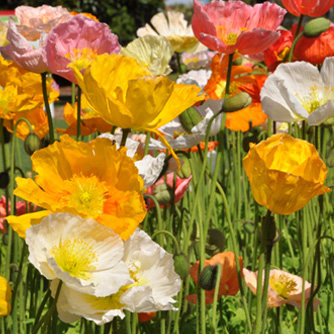
Iceland poppies are one of the easiest poppies to grow
Iceland poppy (Papaver nudicaule)
This is the most popular of all the poppies as it is easy to grow in all climates and is readily available as seeds or punnets. It’s an annual with flowers in soft shades of yellow, gold, pink, salmon, red and white which grow above green lacy foliage. Flowers grow to a height of 60cm and it is the best poppy to use as a cut flower with their long stems and good vase life. Pick the flowers early in the morning and make sure you recut the stem and change the water each day. Great for pots, massed plantings or even as an edging plant.
Flanders poppy (Papaver rhoeas)
As mentioned above, this poppy is the remembrance poppy. It has distinctive blood red coloured petals with a black centre. Seeds of Flanders poppies are best sown in situ in autumn and they tend to do best in climates that have cooler winters. It’s also an annual but self seeds readily and is another poppy which makes a good cut flower.
Oriental poppy (Papaver orientale)
The Oriental poppy provide the largest blooms of all the poppies and makes a cracker of a display in colours of orange, pink, salmon and white. Flowers can be single or double and usually have a dark centre (but not always). Foliage may be green or a striking blue/grey colour. These perennial poppies can be purchased as plants or seed. If starting with seed sow them directly in the soil as they don’t like root disturbance. Reaching a height of 60 – 100cm they flower throughout late spring and summer and will self seed easily.
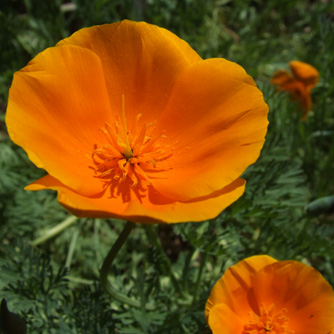
Californian poppies are another very easy poppy
Californian poppy (Eschscholzia californica)
This gorgeous orange flowering poppy makes a true statement in spring especially when planted en masse. Native to Mexico and the bottom of North America this poppy can take hotter, drier conditions so it does well Australia wide. While orange is the most common colour there are also bright and pale yellow varieties. Californian poppies are prolific self seeders so think twice before planting near bushland areas.
Blue Himalayan Poppy (Meconopsis baileyi syn. betonicifolia)
With stunning sky blue flowers this is the poppy everyone wants to grow! However the bad news is that for most of Australia they are impossible or extremely difficult at best. Coming from the Himalayas they require cold winters and very mild summers. They need plenty of protection from our harsh sun and are thirstier than other poppies and must be kept moist. Officially a perennial but in our difficult climate they’re more likely to be short lived. Some varieties will set seed.
Welsh poppy (Meconopsis cambrica)
This delightful perennial poppy grows well in cold areas but can handle more warmth and a bit more dryness than the Himalayan poppy. Flowers are mainly golden yellow but there are some rare cultivars around that are red and orange. This poppy works well planted in drifts under trees as it can take quite a lot of shade. In warm weather it will die down and resprout again next season. Seed takes a long time to germinate and is best sown directly into slightly acidic soil.
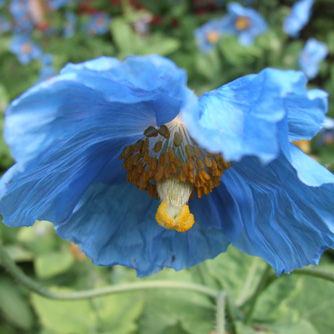
Much loved but much harder to grow is the Blue Himalayan Poppy
How To Grow Poppies
Poppies are frost hardy, easy plants to grow from seed, punnets or small plants once you’ve picked the right one for your climate. If in doubt go with Iceland or Californian poppies – they’re the easiest for all climates.
Most poppies prefer a full sun position and all enjoy lots of compost and manure added to the soil before planting. If starting with seed then sow into trays or directly into the soil. Poppies develop a long tap root and don’t like being moved so take care when planting out seedlings. Late summer and autumn is the time to sow poppy seed and it should be sown sparsely as the seed is very fine. Cover with a light sprinkling of seed raising mix and firm down. Water in with OCP eco-seaweed. Germination takes 10-21 days. Keep soil moist during this time but not constantly wet as this can cause rotting. Thin out seedlings if necessary.
When the seedlings are ready gently plant them into the garden and water in with eco-seaweed to minimise transplant shock. Mulch with a certified organic mulch such as sugar cane.
If starting with punnets these should still be planted in autumn to allow time for a strong plant to develop through winter and to get the best flowering in spring and summer.
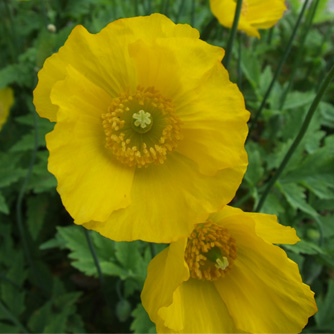
Welsh poppies can also be tricky in our climate
Fertilising and Maintenance of Poppies
If you improved the soil before planting (with manures and compost) then all that’s left is to give the poppies some OCP eco-seaweed and OCP eco-aminogro every 2-4 weeks throughout the growing season. This will encourage bigger plants and give you more flowers.
Remove any dead flowers by cutting off the flower stalk at the base of the plant and this will encourage further flowering. With perennial poppies foliage can be cut back in autumn when it yellows to make way for fresh new growth.
Pests and Diseases of Poppies
While poppies are pretty tough things they are susceptible to a range of rots and mildews. This can mostly be avoided by always planting in free draining soil and having good air circulation around the plants. If powdery mildew strikes then spray with an organic fungicide.
Protect seedlings from snails and slugs by sprinkling OCP eco-shield pellets around.
Any aphids or mites can be controlled with sprays of OCP eco-oil or OCP eco-neem to fix things quick smart.
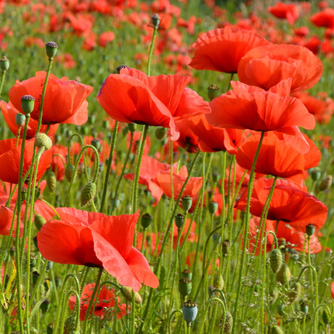
Flanders poppies are much easier and look great en masse!

Enormous Oriental poppy flower - just look at the size of the honeybee


